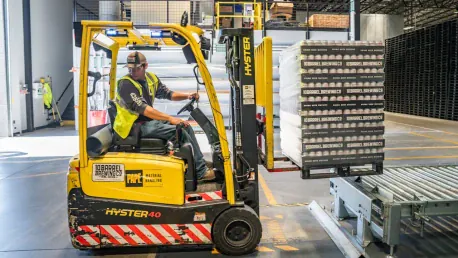The ongoing issue of environmental degradation and energy constraints has led global entities to focus on mitigating CO2 emissions, particularly from energy-intensive industries. Among these, the manufacturing sector stands out, consuming over half of national energy resources, hence contributing significantly to carbon emissions. In China, the manufacturing industry’s substantial share of 36% in global CO2 emissions, primarily through processes such as welding, underscores the urgency for more environmentally sound practices. Given the alarming rise in global temperatures and environmental challenges, it becomes imperative to adopt low-carbon solutions across all facets of industrial operations.
The Environmental Impact of Manufacturing
The typical energy sources for manufacturing – chiefly coal and crude oil – result in significant thermal power supply, leading to extensive CO2 and greenhouse gas emissions. Welding, a ubiquitous industrial process, presents considerable opportunities for reducing overall energy consumption and associated carbon outputs. The manufacturing sector’s reliance on these energy sources makes it a prime target for carbon reduction strategies. Reducing emissions in this sector not only helps in conserving energy but also plays a crucial role in achieving global sustainability goals. Moreover, adopting cleaner methods in welding can serve as a model for other manufacturing processes that rely heavily on fossil fuels.
Chronic issues such as high energy consumption and pollution are exacerbated by the use of conventional welding technologies. The carbon footprint of welding extends beyond the direct emissions during the welding process, encompassing energy consumption during transport, preheating, and the use of auxiliary equipment. Incorporating efficient energy use practices in welding can pave the way for substantial reductions in carbon emissions. Furthermore, manufacturers must consider the broader implications of their processes. By implementing more efficient production methods, not only can they reduce their environmental impacts, but they can also potentially lower operating costs, leading to enhanced economic performance.
Understanding Low Carbon Welding Scheduling Problem (LCWSP)
This research is centered on the Low Carbon Welding Scheduling Problem (LCWSP), a crucial aspect that can help mitigate the environmental footprints of the welding industry. LCWSP is an extension of the Flow Shop Scheduling Problem (FSSP) with added complexities due to the variety of welding processes and the need to manage carbon emissions alongside traditional economic indicators like manufacturing cycle time and machine load. Managing such a compounded problem requires innovative approaches that can adeptly balance the twin objectives of efficiency and sustainability.
The traditional Flow Shop Scheduling Problem (FSSP) focuses on optimizing the sequence of operations to minimize production time and maximize machine utilization. However, LCWSP introduces an environmental dimension by incorporating carbon emission metrics. In essence, LCWSP allows for one job to be processed by multiple welding machines, thus breaking the conventional one-to-one job-machine assignment norm found in FSSP. This flexibility enables manufacturers to select optimal machine combinations that minimize energy consumption and emissions while maintaining productivity. The objective is to develop production schedules that are not only efficient but also environmentally responsible.
Energy Consumption and Emissions in Welding
The dynamics of welding vis-à-vis carbon footprint include energy use during transport, preheating, actual welding, and use of auxiliary equipment. Incorporating carbon emissions into welding production metrics is essential for developing effective low-carbon scheduling strategies. The significant energy consumption during these stages highlights the potential for substantial carbon footprint reduction through optimized scheduling. For instance, precise scheduling that minimizes idle machine time can significantly reduce energy usage, thus lowering emissions.
In addition, initiatives like adopting energy-efficient welding technologies and integrating renewable energy sources into production lines can further reduce the environmental impact. The emphasis should not only be on direct energy consumption but also on improving overall energy management across different stages of welding. Improving process efficiency and investing in energy-saving technologies are key to achieving a low-carbon welding operation. Integrating advanced monitoring systems can also provide real-time data on energy use and emissions, aiding in the continuous improvement of low-carbon strategies.
Research Landscape and Methodologies
Previous research on Flow Shop Scheduling (FSSP) has yielded numerous methodologies for improving productivity and environmental performance. Studies such as those by May et al., Yenisey and Yagmahan highlight multi-objective FSSP techniques. LCWSP differs from FSSP primarily in allowing one job to be processed by multiple welding machines, breaking the one-to-one job-machine assignment norm. These advancements illustrate the ongoing evolution in scheduling methodologies aimed at accommodating environmental considerations alongside traditional economic metrics.
In the landscape of research, methodologies that integrate both production efficiency and environmental impact have gained prominence. The transition from single-objective to multi-objective optimization techniques marks a significant shift in research paradigms. Innovative approaches such as genetic algorithms, particle swarm optimization, and the Grey Wolf Optimizer (GWO) are increasingly being employed to address the complexities of LCWSP. These algorithms facilitate the simultaneous optimization of multiple criteria, thus enabling more balanced and sustainable scheduling decisions.
Current Research Applications
Noteworthy contributions include Karaoglan’s exploration of variable workstation constraints in industrial WSP and Lu et al.’s investigation into human-robot collaborative WSPs aimed at minimizing makespan and energy use. There’s significant attention on objective-oriented research focusing on machine load and cycle time yet insufficient emphasis on carbon footprint considerations. Addressing this gap, researchers are now prioritizing the inclusion of carbon emissions as a key performance metric, reflecting a broader shift towards sustainable manufacturing practices.
Collaborative approaches, such as human-robot workstations, present exciting possibilities for optimizing resource use and reducing emissions. These setups enhance the efficiency and safety of welding operations while also providing opportunities for further energy savings. Moreover, by leveraging advanced sensors and real-time data analytics, these systems can continually adjust their operations to maintain optimal performance. The integration of such technologies highlights the expanding horizon of LCWSP research and its potential applications across diverse manufacturing sectors.
Significance of Carbon Footprint Considerations
The consensus in research supports the necessity of integrating carbon emission metrics into production scheduling, particularly in energy-intensive domains like welding. The use of intelligent algorithms, such as the Grey Wolf Optimizer (GWO), and its improved versions illustrate a pivotal shift towards more sophisticated, multi-objective scheduling approaches that balance economic performance with environmental impacts. By emphasizing carbon footprint considerations, researchers are fostering more responsible manufacturing practices that align with global sustainability goals.
Evaluating the environmental impact of welding schedules prompts manufacturers to adopt more holistic and forward-thinking approaches to their operations. The development of low-carbon strategies necessitates a comprehensive understanding of the production processes and their associated emissions. As such, the integration of carbon metrics into scheduling algorithms ensures that environmental considerations are factored into production decisions from the outset. This paradigm shift represents a significant step towards achieving sustainable industrial practices that benefit both the economy and the environment.
Research Methodology – Mathematical Models and Algorithms
The paper presents a mathematical model to minimize both makespan and carbon emissions, involving various variables such as job sequencing, number of machines, and job-specific parameters (e.g., welding time, preheating time). The improved Grey Wolf Algorithm (IGWO) designed for this study employs a double-layer coding scheme, using random and NEH initialization methods to enhance population diversity and optimization performance. This approach allows the algorithm to explore a vast solution space effectively, improving its chances of finding optimal or near-optimal solutions.
The IGWO’s multi-layered approach enhances its flexibility and robustness, catering to the diverse requirements of LCWSP. By incorporating both random and structured initialization methods, the algorithm ensures a balanced exploration of potential solutions. Such methodologies highlight the importance of innovative algorithm design in addressing multi-objective optimization problems. The IGWO’s ability to adapt to various problem scales further underscores its utility in practical applications, indicating significant potential for adoption in the industrial sector.
Proposed Strategies and Practical Applications
Multi-wandering Search Strategy
Designed to expand the search range and improve optimization capabilities by systematically altering job sequences and machine allocations during algorithm iterations. This strategy ensures a comprehensive exploration of potential solutions, enhancing the likelihood of identifying optimal scheduling configurations. By continually adjusting job-machine assignments, the algorithm maintains a high degree of flexibility and adaptability.
Moreover, the multi-wandering search strategy aids in avoiding local optima, ensuring that the algorithm does not prematurely converge on suboptimal solutions. This exploration-centric approach aligns with the overarching goal of achieving sustainable production schedules that balance efficiency and carbon emissions. The robustness of this strategy is particularly pertinent given the complex and dynamic nature of industrial welding operations, where constant adjustments and optimizations are vital for maintaining optimal performance.
Coordinated Hunting Strategy
Enhances the IGWO by dynamically adjusting wolf roles based on fitness values, thereby improving convergence to optimal solutions. This adaptive approach allows the algorithm to fine-tune its search process, balancing exploration and exploitation effectively. By dynamically adjusting search parameters, the coordinated hunting strategy ensures that the algorithm remains responsive to varying problem conditions.
This strategy’s ability to adapt to changing fitness landscapes elevates the performance of the IGWO, making it a powerful tool for tackling LCWSP. The dynamic role adjustment mechanism ensures that the algorithm remains versatile, capable of responding to diverse scheduling challenges in real-time. Consequently, this strategy enhances the feasibility of IGWO’s implementation in industrial settings, providing a scalable solution for low-carbon welding scheduling.
Critical Path Adjustments
Emphasizes finding an appropriate number of machines for jobs on critical paths to balance makespan against carbon emissions. By focusing on critical path jobs, the strategy ensures that key processes are optimized for both time efficiency and environmental impact. This targeted approach allows for tailored optimizations that address the specific demands and constraints of critical welding tasks.
The critical path adjustments strategy exemplifies the precision and targeted intervention necessary for achieving optimal low-carbon schedules. By identifying and prioritizing critical jobs, this methodology ensures that resource allocation and process optimization are strategically aligned with environmental objectives. This focus on critical paths not only bolsters schedule efficiency but also significantly contributes to reducing overall carbon emissions, aligning with broader sustainability targets.
Key Findings and Results
The enhanced IGWO demonstrated superior performance in minimizing makespan and carbon emissions compared to traditional GWO and the NSGA-II algorithm. Simulation experiments validate the IGWO’s effectiveness across varying problem scales, highlighting its potential for practical deployment in industrial settings. The empirical results underscore the algorithm’s robustness and adaptability, showcasing its capacity to address the multifaceted challenges of LCWSP.
These findings bolster the case for adopting advanced optimization algorithms in industrial scheduling. The demonstrated efficiency and environmental benefits of IGWO signify a major leap forward in sustainable manufacturing practices. Furthermore, the algorithm’s scalability and adaptability indicate its potential for widespread application across diverse industrial contexts, paving the way for broader adoption of low-carbon strategies.
Industrial Application and Future Directions
The ongoing problem of environmental degradation and energy shortages has prompted global efforts to reduce CO2 emissions, focusing especially on energy-heavy industries. The manufacturing sector is particularly prominent in this context, as it uses more than half of a nation’s energy resources and greatly contributes to carbon emissions. In China, the manufacturing sector is responsible for 36% of global CO2 emissions, with processes like welding playing a significant role. This significant share highlights the urgent need for more environmentally-friendly practices in manufacturing and related industries.
As global temperatures continue to rise and environmental challenges become more severe, it is crucial to implement low-carbon solutions in all areas of industrial operations. This shift towards greener practices is not just essential but urgent. Failing to take meaningful action will only escalate the existing environmental crisis, making it harder to reverse its effects in the future. By adopting sustainable practices now, industries can help reduce their carbon footprints and contribute to a more stable and healthy environment. This includes investing in energy-efficient technologies, using cleaner production methods, and prioritizing renewable energy sources. Reducing carbon emissions in such a significant sector can make a substantial difference, helping to mitigate the negative impacts of climate change and promote a more sustainable future for generations to come.









